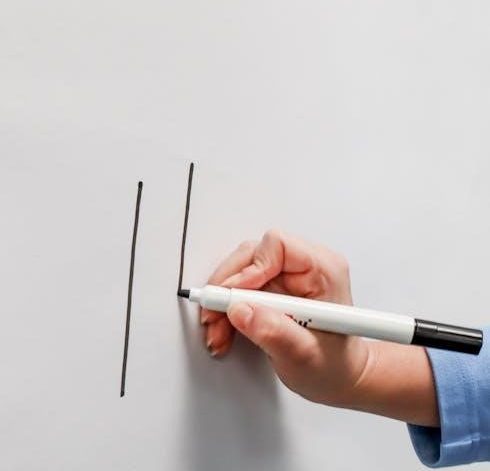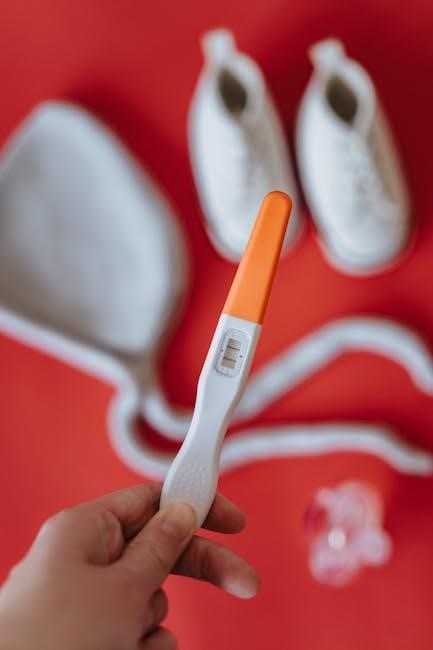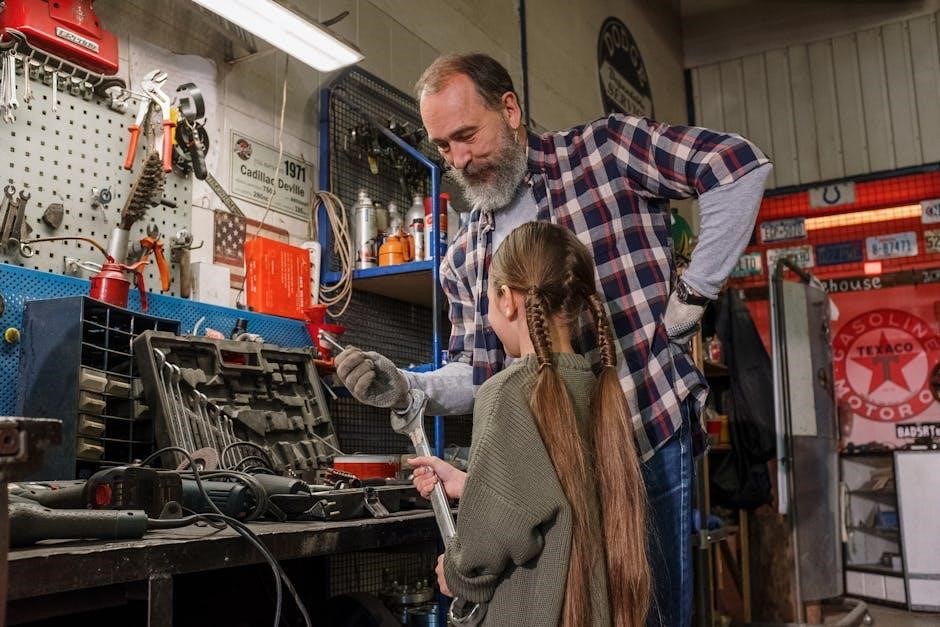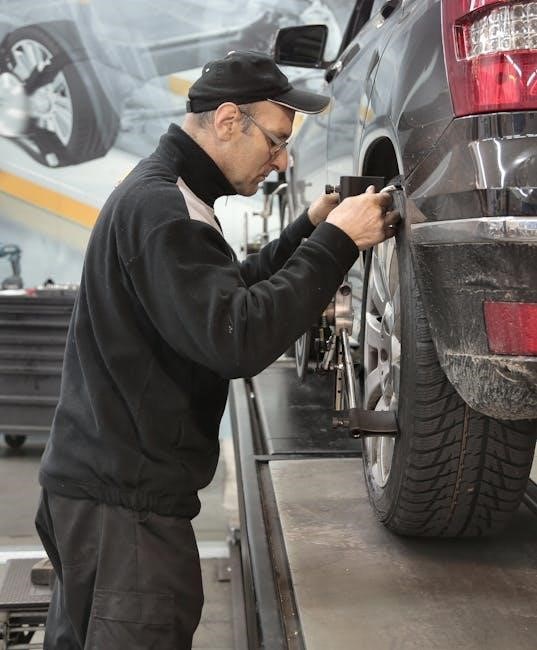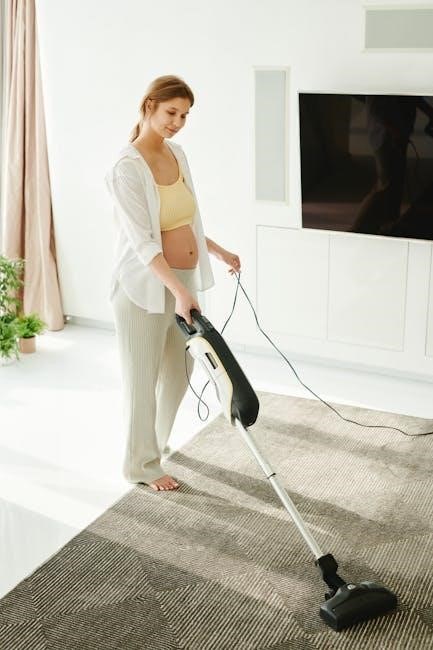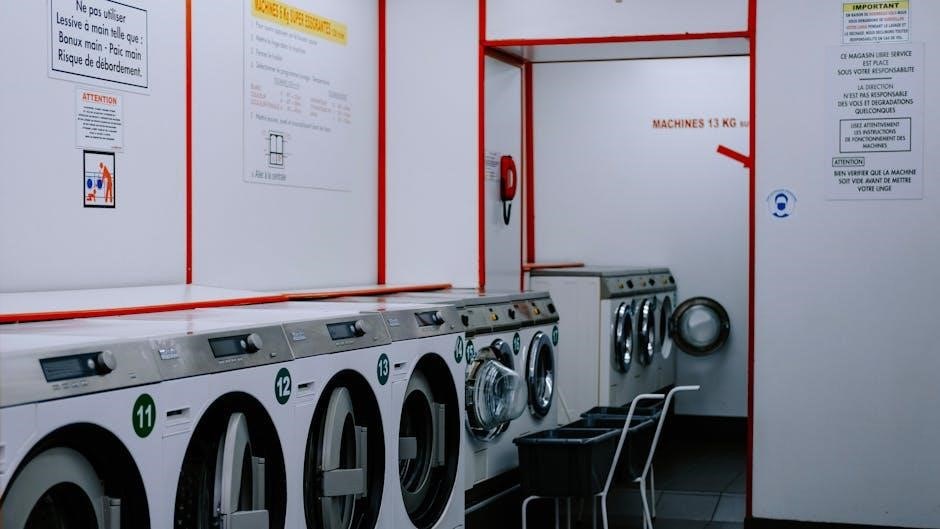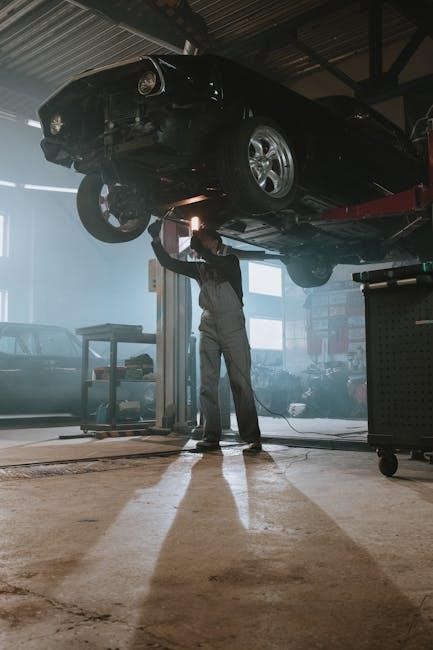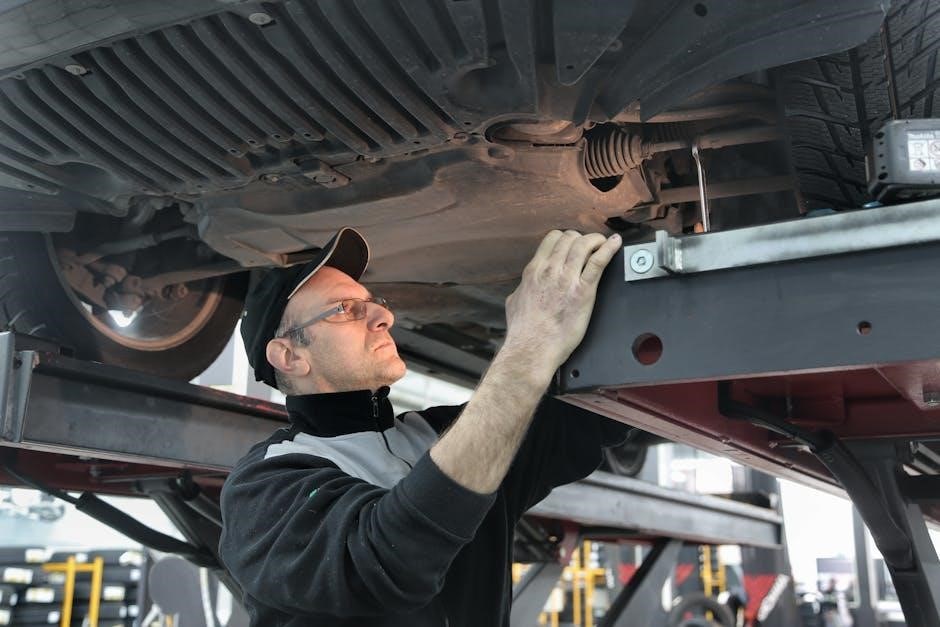Welcome to the Mirro Pressure Cooker Instruction Manual! This comprehensive guide provides essential information for safe and effective use of your pressure cooker, ensuring optimal cooking results and longevity of the appliance.
1.1. Overview of the Mirro Pressure Cooker
The Mirro Pressure Cooker is a versatile and efficient kitchen appliance designed to simplify cooking while retaining nutrients. Available in various models, including the Mirro-Matic 6-quart and 4-quart options, it offers durability and ease of use. The cooker features a sturdy construction, advanced safety mechanisms, and user-friendly controls. It is ideal for preparing a wide range of dishes, from hearty stews to tender meats, and is also suitable for canning. The pressure cooker comes with a comprehensive manual and recipe book, providing guidance for both novice and experienced users. Its ability to reduce cooking time by up to 70% makes it a valuable addition to any kitchen, ensuring faster and healthier meal preparation.
1.2. Importance of Reading the Manual
Reading the Mirro Pressure Cooker Instruction Manual is crucial for safe and effective use of the appliance. The manual provides detailed safety precautions, operating instructions, and troubleshooting tips to ensure optimal performance. It outlines essential guidelines to prevent accidents, such as proper lid alignment and pressure regulation. Understanding the cooker’s features and functions through the manual helps users avoid common mistakes, like exceeding recommended pressure levels or improper sealing. Additionally, the manual includes recipes and cooking timetables tailored for the Mirro Pressure Cooker, helping users achieve the best results. Neglecting to read the manual can lead to unsafe conditions, damaged appliances, or unsatisfactory cooking outcomes. Always refer to the manual before first use and as a reference for ongoing operation.
1.3. Safety Precautions
Safety is paramount when using the Mirro Pressure Cooker. Always read and follow the manual’s guidelines to avoid accidents; Ensure the lid is properly aligned and sealed before cooking. Never leave the cooker unattended while in operation. Keep children away from the appliance, and avoid touching hot surfaces or steam vents. Regularly inspect the gasket, valve, and other components for wear or damage. Do not exceed recommended pressure levels or cooking times. Always allow the pressure to release naturally or via the quick-release method as instructed. Failure to adhere to these precautions can result in burns, explosions, or damage to the appliance. Prioritize safety to ensure a secure and enjoyable cooking experience.

Understanding Your Mirro Pressure Cooker

Understanding your Mirro Pressure Cooker is key to unlocking its full potential. This section introduces you to the cooker’s design, features, and functionality, ensuring you use it efficiently and safely.
2.1. Key Features of the Mirro Pressure Cooker
The Mirro Pressure Cooker is designed with advanced features to enhance your cooking experience. It includes multiple models, each offering durable construction, easy-to-use controls, and safety mechanisms. Key features include a pressure regulator, locking lid, and automatic shut-off for added safety. The cooker is built with high-quality materials, ensuring longevity and efficient performance. It also comes with a comprehensive manual, complete with recipes and troubleshooting guides. Whether you’re cooking meals or canning, the Mirro Pressure Cooker is equipped to handle a variety of tasks efficiently, making it a versatile addition to your kitchen.

2.2. Components of the Pressure Cooker
The Mirro Pressure Cooker consists of several key components that ensure safe and efficient operation. The main pot is made of durable stainless steel or heavy-duty aluminum, providing excellent heat distribution. The locking lid features a secure sealing mechanism to maintain pressure. A pressure regulator is included to control and monitor cooking pressure accurately. Additional components include a steam vent, safety valve, and handles for easy lifting. Some models also come with a timer and digital controls for precise cooking. These components work together to ensure that your cooking experience is both safe and effective, while also making the cooker easy to use and maintain.
2.3. Different Models of Mirro Pressure Cookers
Mirro offers a variety of pressure cooker models to suit different cooking needs and preferences. The Mirro-Matic series includes 4-quart and 6-quart options, perfect for small to medium-sized families. The Mirro Speed Pressure Cooker is designed for faster cooking, featuring advanced pressure regulation. Other models, like the Mirro 92140, combine durability with user-friendly designs. Each model may include additional features such as timers, digital controls, or specialized canning capabilities. The range ensures that users can choose the ideal cooker for their lifestyle, whether for everyday meals or preserving food. Refer to the manual for specific details about your model’s features and operation.

Safety Guidelines
Always read the manual and follow safety guidelines to prevent accidents. Understanding your cooker’s features and proper usage is crucial for safe and efficient cooking experiences.
3.1. Essential Safety Tips
Ensuring safety while using your Mirro Pressure Cooker is paramount. Always read the manual thoroughly before first use and follow all instructions carefully. Never touch hot surfaces or handles without proper protection. Keep children away from the cooker while it is in operation. Regularly inspect the gasket and valve for wear and tear, replacing them as needed. Avoid overfilling the cooker, as this can lead to clogging or unsafe pressure levels. Always monitor the pressure gauge and regulator during cooking. If you notice any unusual noises or leaks, stop use immediately and consult the troubleshooting section. Proper maintenance and adherence to these tips will ensure safe and efficient cooking experiences.
3.2. Understanding Pressure Cooker Components
Familiarizing yourself with the components of your Mirro Pressure Cooker is crucial for safe and effective operation. The lid features a locking mechanism to secure it in place, ensuring a tight seal during cooking. The gasket is a rubber ring that prevents steam from escaping, maintaining pressure inside the cooker. The pressure regulator controls the pressure level, while the safety valve releases excess pressure if it becomes too high. Additional components include the handle for easy lifting, the vent pipe for steam release, and the pressure gauge to monitor internal pressure. Understanding these parts ensures proper use and maintenance of your pressure cooker.
3.3. Basic Safety Precautions
Adhering to basic safety precautions is essential when using your Mirro Pressure Cooker to prevent accidents and ensure safe operation. Always read the manual thoroughly before first use. Never leave the cooker unattended while it is in operation. Keep children away from the appliance, and avoid touching hot surfaces or steam. Use oven mitts or tongs to handle hot lids or containers. Ensure the cooker is placed on a stable, heat-resistant surface. Regularly inspect the gasket and other components for wear and tear. Never force the lid open; allow pressure to release naturally. Follow recommended pressure levels and cooking times to avoid over-pressurization. Proper adherence to these precautions ensures a safe and enjoyable cooking experience with your Mirro Pressure Cooker.

Operating Your Mirro Pressure Cooker
Mastering the operation of your Mirro Pressure Cooker involves following a step-by-step guide to ensure safe and efficient cooking. Begin by preparing ingredients, then add liquid and seasonings. Secure the lid properly, ensuring the gasket is aligned. Set the regulator to the desired pressure level and monitor the cooking time. Never leave the cooker unattended during operation. Allow pressure to release naturally or quickly, depending on the recipe. Always follow the manufacturer’s guidelines for specific foods to achieve perfectly cooked meals every time. Proper operation ensures both safety and delicious results.
4.1. Step-by-Step Guide to Using the Pressure Cooker
Using your Mirro Pressure Cooker is straightforward when following these steps. Begin by adding ingredients and liquid to the cooker, ensuring not to exceed the recommended fill level. Secure the lid tightly, aligning the gasket properly to ensure a tight seal. Set the pressure regulator to the desired level and place the cooker on your stovetop over medium-high heat; Once steam begins to escape, reduce the heat to maintain consistent pressure. Monitor the cooking time carefully, as pressure cooking significantly reduces typical cooking durations. After cooking, allow the pressure to release naturally or use the quick-release method, depending on the recipe. Always refer to the manual for specific guidelines for different types of food to ensure optimal results and safety.
4.2. How to Regulate Pressure
Regulating pressure in your Mirro Pressure Cooker is essential for safe and effective cooking. Start by ensuring the pressure regulator is properly seated on the vent pipe. For most recipes, set the regulator to the recommended pressure level, typically 10-15 PSI. As the cooker heats, steam will escape, and the regulator will begin to rock gently, indicating pressure is building. Once the desired pressure is reached, reduce the stovetop heat to maintain a steady pressure. Monitor the pressure gauge to ensure it stays within the specified range. If pressure exceeds safe levels, slightly lower the heat. Never force the regulator, as this could damage the cooker. Proper pressure regulation ensures even cooking and prevents potential hazards.
4.3. Cooking Times and Guidelines
Cooking times in your Mirro Pressure Cooker are significantly shorter than traditional methods. Always consult the included recipe book or timetables for specific food guidelines. Ensure the cooker is properly sealed and contains adequate liquid before use. Avoid overfilling, as this can lead to improper sealing and safety risks. Start with shorter cooking times and adjust as needed to prevent overcooking. Use the pressure regulator to maintain the recommended pressure level for your recipe. For best results, follow the cooker’s guidelines for water ratios and cooking durations. Proper timing ensures perfectly cooked meals while retaining nutrients and flavors. Refer to the manual for detailed charts and specific food instructions to achieve optimal results every time.

Canning with Your Mirro Pressure Cooker
Canning with your Mirro Pressure Cooker requires precise pressure regulation and adherence to safety guidelines. Follow the manual’s detailed instructions for maintaining proper pressure during the canning process.
5.1. Preparing for Canning
Preparing for canning with your Mirro Pressure Cooker involves several key steps. First, ensure all jars, lids, and utensils are sterilized to prevent contamination. Next, review the recipe and gather all necessary ingredients. The pressure cooker must be in good working condition, with the gasket, regulator, and other components checked for proper function. Always refer to the manual for specific instructions on preparing your cooker for canning. Additionally, familiarize yourself with the recommended pressure settings and processing times for the type of food you are canning. Proper preparation is crucial for safe and successful canning results.
5.2. Canning Procedures
Following proper canning procedures with your Mirro Pressure Cooker is essential for safety and success. Begin by packing prepared food into sterilized jars, leaving the recommended headspace. Secure lids and rings tightly, then place jars in the cooker. Add the required amount of water and ensure the pressure regulator is correctly set. Process the jars at the specified pressure and time according to the recipe. Maintain consistent pressure throughout the cycle. After processing, allow the pressure to drop naturally before removing the lid. Let jars cool, check seals, and store properly. Always adhere to the manual’s guidelines for safe and effective canning results.
5.3. Safety Tips for Canning
Ensuring safety during canning with your Mirro Pressure Cooker is crucial. Always follow tested recipes and guidelines to avoid improper food preparation. Use sterilized jars, lids, and utensils to prevent contamination. Never overfill jars, as this can lead to seal failure. Secure lids and rings properly to ensure a tight seal. Monitor pressure and temperature during processing, and maintain consistent levels as specified in the manual. Allow the pressure to drop naturally before opening the cooker. Regularly inspect and maintain the pressure cooker’s gasket and regulator. Keep children away during canning, and never leave the cooker unattended. Always follow the manual’s instructions for safe and successful canning results.
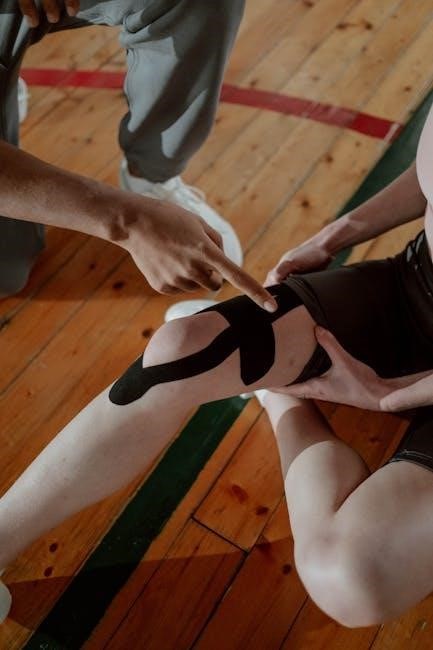
Maintenance and Troubleshooting
Regularly clean and inspect your Mirro Pressure Cooker to ensure optimal performance. Check for wear and tear on seals and gaskets, replacing them as needed. Always follow the manual’s maintenance and troubleshooting guide to resolve common issues and maintain safety.
6.1. Cleaning the Pressure Cooker
Regular cleaning is crucial for maintaining the performance and safety of your Mirro Pressure Cooker. After each use, wash the cooker with mild soap and warm water, paying attention to the lid, gasket, and valve. Avoid using abrasive cleaners or scouring pads, as they may damage the finish or seal. Dry the cooker thoroughly to prevent rust. For tough stains, soak the parts in warm soapy water before scrubbing gently. Sanitize all components by rinsing with clean water. Always refer to the manual for specific cleaning instructions to ensure longevity and optimal function. Proper cleaning also prevents food residue buildup, ensuring safer and more efficient cooking experiences.
6.2. Common Issues and Solutions
Common issues with your Mirro Pressure Cooker may include the pressure regulator not functioning properly, the gasket not sealing, or the cooker not building pressure. For the regulator, ensure it’s clean and free of blockages. If the gasket is worn or damaged, replace it immediately. If the cooker isn’t sealing, check for food residue on the rim and gasket. For pressure issues, verify the valve is open and the lid is aligned correctly. If the cooker hisses excessively, adjust the regulator to maintain steady pressure. Always refer to the manual for troubleshooting steps. Regular maintenance, such as cleaning and inspecting parts, can prevent many of these issues and ensure smooth operation.
6.3. Replacement Parts and Accessories
To maintain your Mirro Pressure Cooker’s performance, genuine replacement parts and accessories are essential. Common replacements include gaskets, valves, and pressure regulators, which ensure proper sealing and pressure control. Accessories like additional cooking racks or steam baskets can enhance versatility. Always purchase parts from authorized dealers to guarantee compatibility and safety. For older models, refer to the manual or contact customer support for assistance. Regularly inspecting and replacing worn components prevents operational issues and extends the lifespan of your cooker. Authentic Mirro parts are designed to meet safety standards, ensuring reliable and efficient cooking experiences.

Recipes and Cooking Tips
Unlock your culinary potential with the Mirro Pressure Cooker! Discover a variety of recipes, from hearty stews to tender meats, and tips for enhancing flavors and textures.
7.1. Quick and Nutritious Meals
With the Mirro Pressure Cooker, preparing quick and nutritious meals is effortless. Utilize its efficiency to retain up to 70% more nutrients compared to traditional cooking methods. This ensures your dishes are not only delicious but also packed with essential vitamins and minerals. The pressure cooker’s ability to significantly reduce cooking time allows you to prepare healthy meals even on the busiest days. From steaming vegetables to cooking lean proteins, the Mirro Pressure Cooker helps you maintain a balanced diet without compromising on flavor or time.
7.2. Pressure Cooker Recipes
The Mirro Pressure Cooker offers a wide variety of delicious and easy-to-make recipes that cater to all tastes and dietary needs. From hearty soups and stews to perfectly cooked grains and proteins, this appliance allows you to explore a world of flavors. Discover recipes for tender meats, vibrant vegetables, and wholesome legumes, all prepared to perfection in minimal time. The pressure cooker’s ability to lock in flavors ensures that your dishes are not only nutritious but also bursting with taste. With included timetables and guidelines, you can achieve precise results every time. Whether you’re preparing a family meal or experimenting with new cuisines, the Mirro Pressure Cooker makes cooking effortless and enjoyable.
7.3. Maximizing Nutrient Retention
Pressure cooking with the Mirro Pressure Cooker is an excellent way to retain essential nutrients in your food. Unlike traditional cooking methods, pressure cooking uses shorter cooking times and minimal water, preserving vitamins and minerals that are often lost in boiling or steaming. The sealed environment of the pressure cooker ensures that nutrients remain locked within the food, delivering healthier and more flavorful meals. By following the guidelines in this manual, you can optimize your cooking techniques to maintain the nutritional value of your ingredients. This method is particularly beneficial for delicate nutrients like Vitamin C and B vitamins, which are easily destroyed by prolonged cooking.

Additional Resources
For more information, visit the official Mirro website for manuals, recipes, and troubleshooting guides. Explore community forums for tips and shared experiences. Contact customer support for assistance.
8.1. Where to Find More Recipes
Discover a variety of delicious recipes in the Mirro Pressure Cooker Manual and online. The official Mirro website offers a wealth of recipe ideas, from hearty stews to quick meals. Explore community forums and social media groups dedicated to pressure cooking for shared recipes and tips. Additionally, the manual includes a comprehensive recipe book with step-by-step instructions and timetables for perfect results. For more inspiration, check out cooking blogs and YouTube channels featuring Mirro Pressure Cooker recipes. These resources will help you maximize your cooking potential and explore new cuisines with ease.
8.2. Online Communities and Forums
Engage with online communities and forums dedicated to pressure cooking for shared experiences, tips, and advice. Platforms like Facebook groups and Reddit host active discussions where users exchange recipes and troubleshooting tips. These forums are ideal for connecting with fellow Mirro Pressure Cooker owners, learning new techniques, and gaining insights into maximizing your appliance’s potential. Additionally, official Mirro forums and social media pages provide direct support and updates. Joining these communities can enhance your cooking journey and help you make the most of your pressure cooker. Always refer to the official manual for safety and accuracy when trying new methods.
8.3. Warranty and Customer Support
Your Mirro Pressure Cooker is backed by a comprehensive warranty, ensuring protection against defects in materials and workmanship. For detailed warranty terms, refer to the official manual provided with your appliance. Customer support is readily available to address any questions or concerns. Contact Mirro directly via phone, email, or through their official website for assistance with troubleshooting, maintenance, or repairs. Additionally, the Appliance Factory Parts website offers genuine replacement parts and resources for older models. Remember to keep your proof of purchase handy for warranty claims; The combination of reliable warranty coverage and dedicated customer support ensures a hassle-free experience with your Mirro Pressure Cooker.
Congratulations on mastering your Mirro Pressure Cooker! With this manual, you’re equipped to cook efficiently and safely. Explore new recipes and enjoy your culinary journey with confidence!
9.1. Final Tips for Using Your Mirro Pressure Cooker
For optimal performance, always follow the Mirro Pressure Cooker Manual guidelines. Experiment with new recipes and adjust cooking times based on your preferences. Regularly clean and maintain your appliance to ensure longevity.
When canning, strictly adhere to safety protocols to preserve food effectively.
Explore the versatility of your pressure cooker by trying various cooking techniques.
Refer to the manual for troubleshooting common issues and replacing parts.
Enjoy the convenience of faster cooking while retaining nutrients in your meals.
Happy cooking with your Mirro Pressure Cooker!
9.2. Enjoying Your Cooking Experience
Cooking with your Mirro Pressure Cooker is a delightful experience that combines efficiency and creativity.
Experiment with diverse recipes, from hearty stews to fresh vegetables, to explore the full potential of your appliance.
The ability to cook meals up to 70% faster allows you to spend more time enjoying the process rather than waiting.
Take pride in preparing nutritious, flavorful dishes that your family and friends will love.
Whether you’re a novice or an experienced cook, the Mirro Pressure Cooker empowers you to create memorable meals with ease.
Savor the joy of cooking and the satisfaction of sharing delicious, home-cooked food with others!

